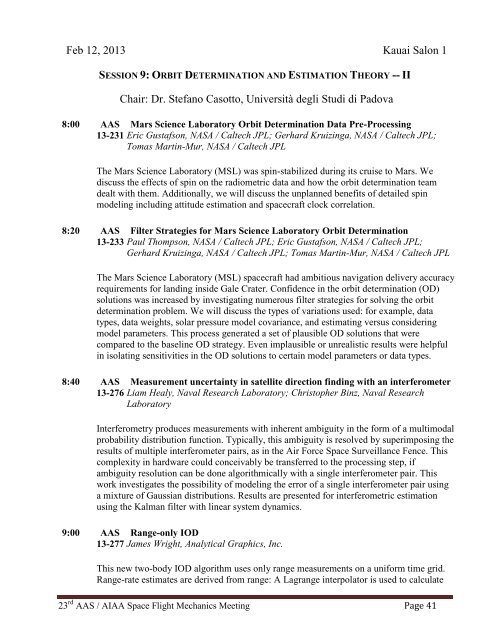meetings - Space Flight Mechanics Committee
meetings - Space Flight Mechanics Committee
meetings - Space Flight Mechanics Committee
Create successful ePaper yourself
Turn your PDF publications into a flip-book with our unique Google optimized e-Paper software.
Feb 12, 2013 Kauai Salon 1<br />
SESSION 9: ORBIT DETERMINATION AND ESTIMATION THEORY -- II<br />
Chair: Dr. Stefano Casotto, Università degli Studi di Padova<br />
8:00 AAS Mars Science Laboratory Orbit Determination Data Pre-Processing<br />
13-231 Eric Gustafson, NASA / Caltech JPL; Gerhard Kruizinga, NASA / Caltech JPL;<br />
Tomas Martin-Mur, NASA / Caltech JPL<br />
The Mars Science Laboratory (MSL) was spin-stabilized during its cruise to Mars. We<br />
discuss the effects of spin on the radiometric data and how the orbit determination team<br />
dealt with them. Additionally, we will discuss the unplanned benefits of detailed spin<br />
modeling including attitude estimation and spacecraft clock correlation.<br />
8:20 AAS Filter Strategies for Mars Science Laboratory Orbit Determination<br />
13-233 Paul Thompson, NASA / Caltech JPL; Eric Gustafson, NASA / Caltech JPL;<br />
Gerhard Kruizinga, NASA / Caltech JPL; Tomas Martin-Mur, NASA / Caltech JPL<br />
The Mars Science Laboratory (MSL) spacecraft had ambitious navigation delivery accuracy<br />
requirements for landing inside Gale Crater. Confidence in the orbit determination (OD)<br />
solutions was increased by investigating numerous filter strategies for solving the orbit<br />
determination problem. We will discuss the types of variations used: for example, data<br />
types, data weights, solar pressure model covariance, and estimating versus considering<br />
model parameters. This process generated a set of plausible OD solutions that were<br />
compared to the baseline OD strategy. Even implausible or unrealistic results were helpful<br />
in isolating sensitivities in the OD solutions to certain model parameters or data types.<br />
8:40 AAS Measurement uncertainty in satellite direction finding with an interferometer<br />
13-276 Liam Healy, Naval Research Laboratory; Christopher Binz, Naval Research<br />
Laboratory<br />
Interferometry produces measurements with inherent ambiguity in the form of a multimodal<br />
probability distribution function. Typically, this ambiguity is resolved by superimposing the<br />
results of multiple interferometer pairs, as in the Air Force <strong>Space</strong> Surveillance Fence. This<br />
complexity in hardware could conceivably be transferred to the processing step, if<br />
ambiguity resolution can be done algorithmically with a single interferometer pair. This<br />
work investigates the possibility of modeling the error of a single interferometer pair using<br />
a mixture of Gaussian distributions. Results are presented for interferometric estimation<br />
using the Kalman filter with linear system dynamics.<br />
9:00 AAS Range-only IOD<br />
13-277 James Wright, Analytical Graphics, Inc.<br />
This new two-body IOD algorithm uses only range measurements on a uniform time grid.<br />
Range-rate estimates are derived from range: A Lagrange interpolator is used to calculate<br />
23 rd AAS / AIAA <strong>Space</strong> <strong>Flight</strong> <strong>Mechanics</strong> Meeting Page 41
















